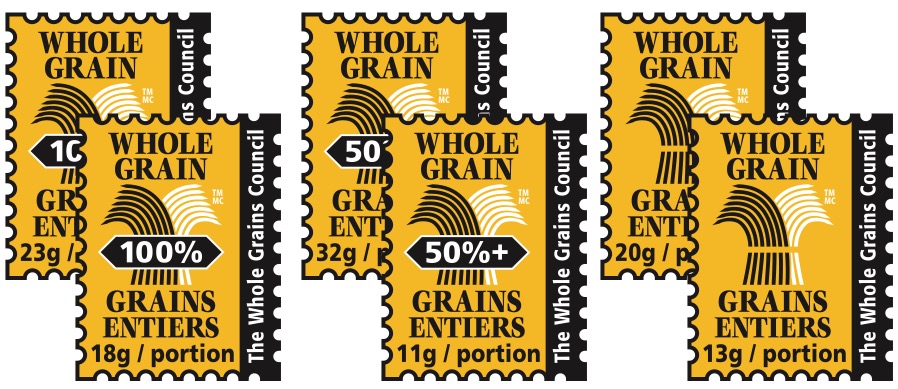Each Stamp shows the amount of whole grain, in grams, in each serving. Products made only with whole grain – and no other ingredients whatsoever – can add a banner saying “100%” to the basic Stamp.
How does the Stamp work in Canada?
In Canada, the 100% Stamp can only appear on products where 100% of the ingredients are whole grain. (In contrast, in the US and most other countries, products where 100% of the grain is whole grain can use the 100% Whole Grain Stamp.) This means that in Canada a bag of brown rice, or a sack of whole grain flour, or a box of oatmeal can use the 100% Stamp, as long as these products have no added non-whole-grain ingredients.
Similarly, in Canada, the 50%+ Stamp can only appear on products where at least half of the product (by weight) is whole grain. (In the US, by contrast, products where at least half of the grain is whole grain, can use the 50%+ Stamp.)
As in the U.S., Canadian products must contain at least 8g of whole grain per serving to bear the Whole Grain Stamp. All requirements for using the Basic Stamp are the same in the U.S. and in Canada.
The Canadian Stamp uses the same colors and key graphics as the U.S. Stamp, but in bilingual form. The illustration here shows the Canadian Basic Stamp on the left, and the 100% Stamp on the right. While this illustration shows the minimum whole grain content for each version of the Stamp, remember that you will see a different number of grams on each Whole Grain Stamp, depending on the whole grain content of a particular product.
Are you a manufacturer interested in using the Whole Grain Stamp in Canada? Click here to access our Canada Stamp info page!
The Stamp Helps you follow Canada’s Food Guide
In 2007, Health Canada updated Canada’s Food Guide, for the first time adding a specific recommendation for whole grains. Here’s what it says:
“Make at least half of your grain products whole grain each day.
-
Eat a variety of whole grains such as barley, brown rice, oats, quinoa and wild rice.
-
Enjoy whole grain breads, oatmeal or whole wheat pasta.”
How many servings do you need?
At least three servings of whole grains are recommended for all Canadians age 9 and up.
The table below shows how many servings of whole grains are recommended by Canada’s Food Guide. In each pair of numbers, the second represents the total servings of grain recommended, and the first represents the minimum amount of whole grain.
For example, teen girls should eat six servings total of grains each day, at least three of which should be whole grain. Want even more health benefits? Make all six servings whole grain!
| age | girls / women | boys / men |
|---|---|---|
| 2-3 | 1.5 to 3 | 1.5 to 3 |
| 4-8 | 2 to 4 | 2 to 4 |
| 9-13 | 3 to 6 | 3 to 6 |
| 14-18 | 3 to 6 | 3.5 to 7 |
| 19-50 | 3 to 7 | 4 to 8 |
| 51+ | 3 to 6 | 3.5 to 7 |
Examples of a serving
Canada’s Food Guide defines a serving of whole grains as any of the following amounts, for products where all the grain ingredients are whole grains:
125 mL (½ cup) cooked rice, barley, bulgur, or other grain
125 mL (½ cup) cooked pasta
1 slice bread (35g)
½ bagel (45g)
30g cold cereal
175 mL (¾ cup) hot cereal (such as oatmeal)
If you’re enjoying whole grains in products that mix whole grains with enriched/refined grains, look for the Whole Grain Stamp to be sure you’re getting at least 8g of whole grains.

